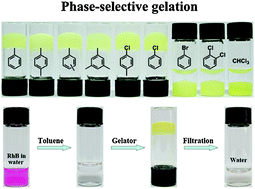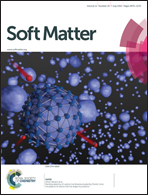An efficient phase-selective gelator for aromatic solvents recovery based on a cyanostilbene amide derivative†
Abstract
Two novel low molecular weight organogelators (LMOGs) 1 and 2 composed of a cholesteryl group, an amide group and various terminal cyanostilbene moieties were synthesized. They could form stable gels in p-xylene. In particular, 2 with more extended π-conjugation length showed remarkable gelation ability in many aromatic solvents, chloroform and chloroform-containing mixed solvents at a relatively low concentration. FT-IR and XRD spectra indicated that the difference between 1 and 2 in the gelation properties may result from the deviation of the intermolecular hydrogen bonding and π–π stacking as driving forces for the formation of the gels. Significantly, 2 can function as an efficient room-temperature phase-selective gelator (PSG) for potential application in the separation and recovery of various aromatic solvents from its mixture with water. Meanwhile, the gelator can be easily recovered and reused several times. Furthermore, the phase-selective gelation properties of 2 can provide a simple and feasible approach for the removal of the rhodamine B (RhB) dye from water.


 Please wait while we load your content...
Please wait while we load your content...